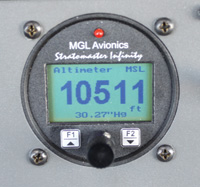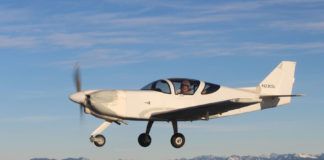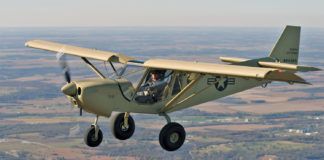MGL Avionics/Stratomaster has been cutting a nice little swath through the EFIS and discrete-electronic-instrument world. They must have 28-hour days in South Africa, where the development is completed, because the rate of product advancement from MGL is just shy of astonishing.

Designed to fit a 2.25-inch instrument hole from the rear, MGL’s new Stratomaster Infinity Singles—like this altimeter—represent a new angle on light, inexpensive Experimental instruments
A new group of 2.25-inch instruments called Infinity Singles uses a common, lightweight plastic case designed to fit a standard instrument hole from the back side; the previous singles were intended to be mounted to the front side of the panel. (The new Infinitys can be front-mounted as well, but the bezel is relatively thick.)
Lucky 13
Thirteen instruments make up the Infinity series, covering the majority of discrete items you’d want. In rearranging the panel in my Glastar Sportsman, I ran out of room for the United 3.125-inch altimeter originally installed, but I had an open 2.25-inch hole. My options in unpowered altimeters were either an inexpensive single-needle altimeter or a very expensive (like $3500!) 2.25-inch three-pointer job.
Drilling down a bit brought me right to MGL, whose ALT-1 is light, available and, at $250, the least expensive option I could find for a backup altimeter—it even includes a density altitude calculator (when fitted with an OAT probe), altitude alerting and a VSI. I checked, and it doesn’t do dishes, but maybe that’s in Version 2.0.
Put It There, Pal
Installation proved largely straightforward. Populate a DB-9 connector with power and ground, and hook the barb-end static port into the ship’s system. This last item required a bit of jiggery-pokery in the form of a reducing fitting—the barb is nominally 0.182 inches in diameter, increasing to 0.194 at the flange. It needs a 3⁄16-inch connector hose. MGL would do itself a favor by adopting standard pitot/static connections; you can’t go wrong with an eighth-inch NPT fitting on the back.
Plumbed in and powered up—the ALT-1 will run on 8 to 32 volts, and consumes 30mA at 13.8 volts with the backlight on, 15mA with the backlight off—the instrument starts to show its stuff. The main display has current altitude in large numerals, using about a third of the 64 vertical pixes. There are two small lines above and two below to show modes, a numeric VSI, actual barometric pressure and the local pressure setting (at the very bottom). In the standard mode, the rotary knob adjusts the altimeter/baro setting, approximately one hundredth of an inch per too-light click. While the main altitude readout is legible under most circumstances, the tiny type of the baro readout invokes a squint or two.
Complaints with answers: As we went to press, MGL’s West Coast rep told me that the instrument line was being upgraded with a sturdier detent in the rotary control and that larger numerals for the baro display were being considered.
The ALT-1 is rated for -700 to 40,000 feet with 10-foot resolution; the analog VSI is scaled at 2000 fpm maximum, though the instrument can resolve and display higher rates in integer form. Accuracy is stated as +/-30 feet at sea level; my ALT-1 agreed within 20 feet of a recently tested (to be dead on) Dynon EFIS-D100. (Better than my $600 United mechanical altimeter ever did.)
Pushing the small button to the right of the knob brings up the secondary screens, which include a graphical VSI, a “deviation altitude” page—basically an altitude alerter—then the density-altitude display and finally a dedicated OAT page. These last two are available when you hook up the optional OAT probe.
This instrument is easy to appreciate. It is light (90 grams, or a bit more than 3 ounces), easy to work, power efficient (with the backlight off, a single 9-volt battery would be good for 25 hours or so) and a great value when you consider the features.
For more information, call 877/835-9464 or visit www.mglavionics.com.













